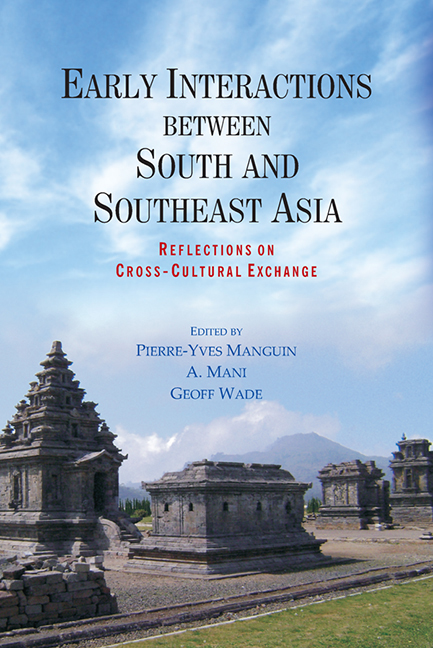Book contents
- Frontmatter
- Contents
- FOREWORD
- Preface
- Introduction
- PART I New Archaeological Evidence from South Asia and Southeast Asia
- PART II Localisation in Southeast Asia
- 11 Tamil Merchants and the Hindu-Buddhist Diaspora in Early Southeast Asia
- 12 The Spread of Sanskrit in Southeast Asia
- 13 The Early Inscriptions of Indonesia and the Problem of the Sanskrit Cosmopolis
- 14 Indian Architecture in the ‘Sanskrit Cosmopolis’: The Temples of the Dieng Plateau
- 15 The Importance of Gupta-period Sculpture in Southeast Asian Art History
- 16 Individuals under the Glaze: Local Transformations of Indianisation in the Decorative Lintels of Angkor
- 17 Early Musical Exchange between India and Southeast Asia
- 18 Buddhism and the Circulation of Ritual in Early Peninsular Southeast Asia
- 19 Early Buddhism in Myanmar: Ye Dhammā Inscriptions from Arakan
- 20 Hindu Deities in Southern Vietnam: Images on Small Archaeological Artefacts
- 21 ‘The Depositing of the Embryo’ – Temple Consecration Rituals in the Hindu Tradition of South and Southeast Asia: A Study of the Textual and Archaeological Evidence
- 22 Localisation of Indian Infl uences as Refl ected in the Laotian Versions of the Ramayana
- 23 Broken Threads: Contested Histories of Brahminism in Cambodia and Thailand and the Construction of Ritual Authority
- LIST OF CONTRIBUTORS
- INDEX
18 - Buddhism and the Circulation of Ritual in Early Peninsular Southeast Asia
from PART II - Localisation in Southeast Asia
Published online by Cambridge University Press: 21 October 2015
- Frontmatter
- Contents
- FOREWORD
- Preface
- Introduction
- PART I New Archaeological Evidence from South Asia and Southeast Asia
- PART II Localisation in Southeast Asia
- 11 Tamil Merchants and the Hindu-Buddhist Diaspora in Early Southeast Asia
- 12 The Spread of Sanskrit in Southeast Asia
- 13 The Early Inscriptions of Indonesia and the Problem of the Sanskrit Cosmopolis
- 14 Indian Architecture in the ‘Sanskrit Cosmopolis’: The Temples of the Dieng Plateau
- 15 The Importance of Gupta-period Sculpture in Southeast Asian Art History
- 16 Individuals under the Glaze: Local Transformations of Indianisation in the Decorative Lintels of Angkor
- 17 Early Musical Exchange between India and Southeast Asia
- 18 Buddhism and the Circulation of Ritual in Early Peninsular Southeast Asia
- 19 Early Buddhism in Myanmar: Ye Dhammā Inscriptions from Arakan
- 20 Hindu Deities in Southern Vietnam: Images on Small Archaeological Artefacts
- 21 ‘The Depositing of the Embryo’ – Temple Consecration Rituals in the Hindu Tradition of South and Southeast Asia: A Study of the Textual and Archaeological Evidence
- 22 Localisation of Indian Infl uences as Refl ected in the Laotian Versions of the Ramayana
- 23 Broken Threads: Contested Histories of Brahminism in Cambodia and Thailand and the Construction of Ritual Authority
- LIST OF CONTRIBUTORS
- INDEX
Summary
The paper examines the circulation of Buddhist thought and ritual in ‘early Southeast Asia’ up to about CE 1000. It does not attempt a chronological narrative, but concentrates on the significance of relics and images and the circulation of ritual as seen from the mass production of clay images and stûpas. Although the peninsula was a crossroads or interface with mainland and insular Southeast Asia, and it shared with them certain practices and ideas, in some aspects the peninsula differed, often considerably. The conclusions proposed here for the peninsula cannot be applied in identical terms to any other region.
ORIGINS, LOCALISATION, AND THE CIRCULATION OF IDEAS
The study of religion in Southeast Asia suffers from several problems in conceptualisation, including that of the ‘very idea’ of religion. The interpretation of the artefacts of Buddhism has relied on categories and theories about Indian Buddhism that were developed in the late nineteenth and early twentieth centuries in imperial Europe and in colonised Asia. Buddhism has come to be painted in broad strokes as ‘Hīınayāna’, ‘Mahāyāna’, or ‘Vajrayāna’, which are seen as monolithic and exclusive blocs, as ‘sects’, and even as ‘churches’. Cultural movement is presented as unidirectional; the maps show arrows moving confidently from India and Sri Lanka to Southeast Asia, and stopping there (or moving on to the ‘Far East’). Southeast Asia is portrayed as a passive recipient of Indian ‘influence’, which washed its shores in ‘waves’ over the centuries. The possibility of cross-cultural and trans-regional exchange, of dialogue, or of interaction is rarely raised.
Many of the early categories in the field of Indian (as well as Tibetan and East Asian) Buddhism have since been, refined, revised, or rejected, but the field of Southeast Asian Buddhism, with some notable exceptions, lags well behind (see Skilling 2001a). Even today, much of what is written about the introduction of Buddhism to Southeast Asia and its development is inaccurate and unnecessarily speculative. It remains under the shadow of outdated theories of ‘Indianisation’. It continues to use inappropriate categories, and is skewed by misconceptions about the nature of Buddhism, its ‘sectarian’ identities, and its transmission and expansion.
- Type
- Chapter
- Information
- Early Interactions between South and Southeast AsiaReflections on Cross-Cultural Exchange, pp. 371 - 384Publisher: ISEAS–Yusof Ishak InstitutePrint publication year: 2011



